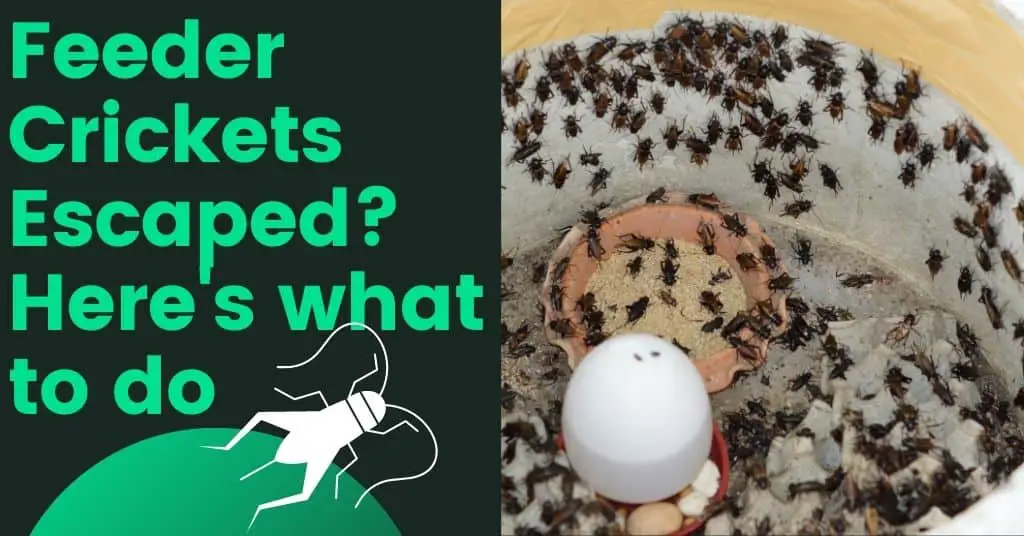
Jeffery Jago is a expert in horticulture and worm breeding. With a background in plant cultivation
Last Updated on May 12, 2021 by Jeffery Jago
Did you know that feeder crickets are escape artists? They can easily get out of virtually any container, so it’s important to take extra precautions to avoid them from getting out of their enclosure and into the house. If they have gotten in, don’t worry! We’ve got the tips and tricks you need to make sure all your feeders stay where they belong.
First of all, we need to identify where the crickets escaped from.
If they escaped from their breeding enclosure:
Crickets are pretty good jumpers, and they’re as small as anything. Finding a way out of the breeding enclosure is a pretty simple task. This happens most of the time because a small hole wasn’t covered up properly, Or there’s a hallow hose leading out of the enclosure, etc. They really can get out of the most absurd small openings and it’s such a hassle sometimes!
The first thing you should note is if your crickets have escaped your breeding enclosure, and they’ve made it any considerable distance, such as outside of the breeding room, they should not be placed back into the general population because they could have picked up bacteria, fungus or parasites. It’s always best to not replace escaped crickets if you are trying to maintain a sterile up-to-code so to say environment.
You should attempt to find out how they escaped and patch it up as quickly as possible to prevent more crickets from escaping.
Some more ways crickets tend to escape their enclosures include:
- Holes cords are being passed through for electrical feeders, heaters or watering systems.
- Mesh that is too large and allows crickets to squeeze through.
- A feeder lid or screen has come loose from the frame inside of their enclosure, making it easier for them to escape.
- Ventilation holes are too big or are too close together, and crickets can escape through them.
- A feeder lid or screen has lost its seal on the enclosure because of a loose screw.
- The wire mesh is not tight enough to make it impossible for crickets to squeeze out between the wires.
- Your annoying cat knocked everything over for the 3rd time this month.
At the bottom of the article, we’ll discuss what to do during a mass ‘jail break’ of crickets.
If they escaped from the reptile enclosure during feeding:
This one is super common and reptile enclosures simply aren’t designed for holding crickets. This can result in a number of escaped crickets before your reptile has a chance to chow down.
The remedy for this is pretty simple, And there’s a lot of things you can do to prevent this from happening in the first place.
- Add your reptile to another box for feeding time, one more appropriately designed not to allow its food to escape its destiny. I’ve seen people use anything from Rubbermaid to cardboard boxes and everything in between.
- Feed your reptile one cricket at a time and keep an eye on it so it doesn’t escape, going as far as to use tweezers if you have to.
- Use a cricket dispenser
During feeding time you may also cover the enclosure inside with paper to prevent the crickets from jumping out of the cage holes, although this can be a little tricky and time-consuming and you will probably give up instantly and move onto one of the other methods.
What to do with the crickets if they are still roaming the house?
If you see them, dispose of them, Otherwise, just let them roam around until they die.
If there are a lot of them, you should try and suck them into the vacuum cleaner as they tend to collect in corners and get stuck in large shag carpets.
You can also place various types of insect traps.
If you’ve got a lot of lizards, you can let them roam around the house and potentially clean up the loose crickets as well!
Overall, haveing a few loose crickets in the house isn’t a big deal and you can just leave them be for a few days or so.
Breeders deal with this sort of thing 24/7 and theirs always crickets on the loose. You just learn to live with it. However, It’s best to have your cricket breeding enclosures set up in a closed room to prevent them from getting loose into your house.
Don’t worry! They’re not dangerous to humans and the only thing it will do is make you itch a little bit when they jump on you or land nearby. It’s just annoying but harmless in all honesty. And if your a breeder your likely not going to get the skeevies just seeing bugs jumping around your house.

